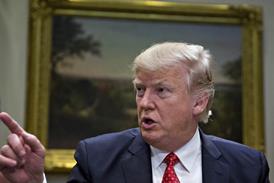Last November, the Federal Deposit Insurance Corporation, the Board of Governors of the Federal Reserve System (FRB), and the Office of the Comptroller of the Currency (OCC) (the ‘agencies’) issued a ‘Joint Statement on Crypto-Asset Policy Sprint Initiative and Next Steps’.


The joint statement is the culmination of recent interagency policy sprints focused on cryptoassets, in which the agencies concluded that ‘public clarity’ (that is, regulation) is warranted in a number of areas. The joint statement sets out a roadmap of planned work for 2022, with a particular focus on providing ‘greater clarity on whether certain activities related to cryptoassets conducted by banking organisations are legally permissible, and expectations for safety and soundness, consumer protection, and compliance with existing laws and regulations’. These activities include:
(a) Cryptoasset safekeeping and traditional custody services, including exchanging cryptoassets and fiat currency, and transaction settlement;
(b) Ancillary custody services, including staking and facilitating cryptoasset lending;
(c) Facilitation of customer purchases and sales of cryptoassets;
(d) Loans collateralised by cryptoassets;
(e) Issuance and distribution of stablecoins (which are digital assets designed to maintain a stable value relative to a reference asset such as a national currency);
(f) Activities involving the holding of cryptoassets on balance sheets; and
(g) The application of bank capital and liquidity standards to cryptoassets.
When will the regulation be implemented, and how severe will it be?
Timing
US regulators have been vocal about the need for crypto-regulation for a while. One prominent advocate is Gary Gensler, the one-time blockchain lecturer who is now chair of the Securities and Exchange Commission, who has repeatedly called for regulation. The agencies, by comparison, have been slow to join in, and it remains to be seen whether the joint statement will translate into concrete steps towards regulation this year. Notably, the joint statement lacks any timeframe for the agencies to issue their guidance, nor does it indicate whether any preliminary analyses have been conducted in relation to the identified crypto-activities. We may, therefore, see a series of further announcements before tangible regulation is put forward.
Severity
The joint statement does not indicate how strict the agencies’ regulation will be. By contrast with China’s zero-tolerance approach to crypto, which saw the country declare all crypto-currency transactions to be illegal in September 2021, the US has generally adopted more balanced rhetoric towards cryptoassets, and even recently approved a bitcoin-linked exchange-traded fund. Furthering this trend, in anticipation of the joint statement, acting head of the OCC Michael J. Hsu said last November: ‘To the extent the OCC’s prior communications have been interpreted as tacit encouragement to engage in crypto-activities, the forthcoming releases will clarify that safety and soundness is paramount. The releases should not be interpreted as a green light or a solid red light, but rather as reflective of a disciplined, deliberative, and diligent approach to a novel and risky area. We will proceed carefully and cautiously and will hold banks to the same.’
The joint statement reflects this stance, referring to the ‘potential opportunities’ as well as ‘risks’ posed by cryptoassets.
Scope
The joint statement refers to regulation of cryptoasset activities carried out by ‘banking organisations’. However, innovation and diversity within the crypto-space is such that not all relevant entities fall neatly within a traditional interpretation of ‘banking regulations’. By way of example:
- Stablecoin issuers act as quasi-banks, issuing their stablecoins to customers in return for fiat deposits. Interestingly, Circle (which issues USDC, the second largest stablecoin) has announced its intention to become a registered bank, while Facebook has partnered with Silvergate Capital to issue Diem. However, other stablecoin issuers, such as Tether Limited (which issues Tether, the largest stablecoin), remain in no man’s land. At present, it is unclear how the agencies could impose regulations on Tether Limited and others without distorting the definition of ‘banking organisations’, and potentially overstepping – or stretching – their authority.
- The joint statement made clear an intent to regulate ‘ancillary custody services’, including ‘facilitating cryptoasset lending’. However, specialised platforms which enable crypto-holders to earn interest by lending crypto-currencies do not naturally fall within the traditional concept of ‘banking organisations’.
This, then, is perhaps the trickiest issue facing the agencies: developing intra vires regulation that (1) covers all of the crypto-activities considered to be in need of ‘clarity’; and (2) covers all of the entities that carry out those activities. Both categories appear to be broad, and to achieve this goal in a coherent way, the agencies will likely have to rely on other US regulatory bodies, such as the SEC, to avoid overstepping their bounds.
What is the anticipated impact on the crypto-market?
The joint statement had little to no immediate impact on crypto-currency prices, particularly in comparison to China’s crypto ban which caused bitcoin to drop by more than $2,000. This is likely because the joint statement only signals future regulation, with little indication of the implementation date, severity or scope. However, a major drop ensued in the weeks following its publication, as bitcoin crashed from all-time-high prices of above $65,000 down to below $50,000. This more significant drop is thought to have been a reaction to the emergence of the new Covid variant, Omicron – and the size of the drop perhaps underlines precisely why the agencies believe ‘clarity’ is required.
With China having a adopted a zero-tolerance approach, and El Salvador going the other way by adopting bitcoin as legal tender, the stage is set (and waiting) for a nation to develop a balanced regulatory framework which looks to benefit from the opportunities of cryptoassets, while protecting its citizens from risks like the freefalling crashes seen regularly on the trading charts.
This signal of intent by the US to regulate cryptoassets puts pressure on other nations to expedite their own cryptoasset regulation, for fear of falling behind. For instance, the Financial Conduct Authority in the UK does not yet regulate cryptoassets, and only requires exchanges to be registered to operate. However, it has demonstrated its willingness to act strongly when required (for example, by banning Binance in June 2021) and has called for further regulation to protect consumers.
Meanwhile, the EU has proposed a dedicated regime for cryptoasset providers with its ‘MiCA’ regulation, under which only licensed providers will be able to conduct crypto-related activities, but could do so in any member state. It remains to be seen whether these and other measures will be expedited by the joint statement.
The joint statement is an implicit recognition by the agencies that cryptoassets are gaining a mainstream presence. As cryptoassets become more popular, the upward trend of litigation involving digital assets will continue – whether they feature at the centre of the dispute or, for example, as the focus of an enforcement or asset-tracing action.
At the same time, we anticipate that an increased focus on regulation and compliance will generate a corresponding increase in investigations and related disputes on – given the nature of the assets – a truly global level.
Kate Gee is counsel and Alasdair Marshall an associate at Signature Litigation





























No comments yet